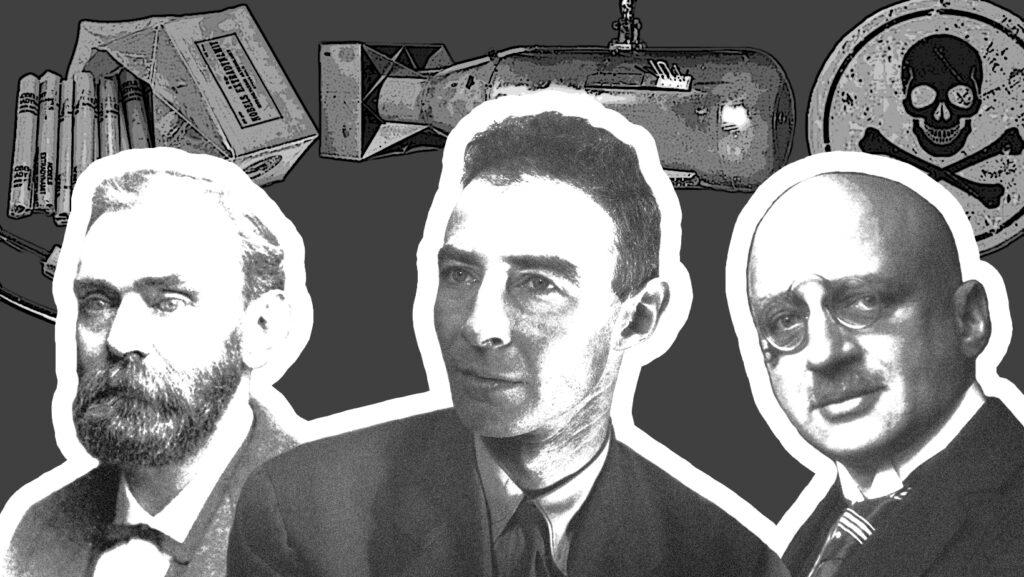
In an episode of “The Big Bang Theory,” Howard Wolowitz expresses some qualms about developing a quantum guidance system in collaboration with the U.S. Air Force. “Sheldon, we could be contributing to a weapons system that oppresses mankind for the next thousand years,” he says. And indeed, Wolowitz has good reason to be nervous. Governments throughout the world are investing in science and technology to achieve and maintain military might, and guidance systems are not only used to control the movement of commercial ships and airplanes, but also of missiles, rockets, satellites, and submarines that, at the flick of a switch, can be diverted for use in reconnaissance and targeted killing missions.
While it is important to note that not all discoveries and inventions were made with death and destruction in mind, numerous events throughout history have shown that science is often co-opted or even downright pursued for evil ends. The delineation between pure and applied research has become blurrier with each passing year, and with every project scientists embark on, questions must be raised about the intended and unintended consequences of their work.
As the following examples show us, it is not enough to be perturbed by the implications of one’s actions and do nothing; scientists must remember their responsibility to humanity and not only be mindful of the impact of their research, but also actively refrain from engaging in work with direct and indirect negative outcomes on mankind.
The merchant of death: Alfred Nobel and dynamite
“Good wishes alone will not ensure peace.”
Alfred Nobel was no stranger to weapons of war. His father Immanuel had been an engineer who operated a mechanical workshop that supplied the Russian army with military equipment during the Crimean War of 1853-1856. While his two eldest sons Robert and Ludvig concentrated on the family engineering enterprise, Immanuel and his youngest sons Alfred and Emil worked on the development of nitroglycerin, a very powerful but also highly unstable explosive, to blast rock, drill tunnels, and build railroads.
Emil’s untimely death in an accidental factory explosion at the tender age of 21 left his father broken, but his brother quite undeterred. A serendipitous moment enabled Alfred to safely harness the explosive power of nitroglycerin through dynamite and gelignite — then the world’s most powerful explosives — and amass enormous wealth from these through a combination of scientific prowess and business acumen. Not even the dismay and horror of Ascanio Sobrero, the inventor of nitroglycerin, gave him pause.
But thanks to a premature obituary due to an alleged case of mistaken identity, Alfred was able to discover what the world saw him as: a man who “became rich by finding a way to kill more people faster than ever before.” As the story goes, a French newspaper had received news of Ludvig’s passing and gotten the names of the brothers mixed up. Shaken to his core, Alfred resolved to rehabilitate his image as “the merchant of death.”
While he still operated under the assumption that the development and proliferation of explosives would serve as an effective deterrent to war through the threat of mutually assured destruction, his friendship with the peace activist Countess Bertha von Suttner, among many other things, pushed him to take a more active interest in international peace efforts and scientific research. Later on, he bequeathed the bulk of his immense fortune to the Nobel Prizes, which are awarded to “those who, during the preceding year, have conferred the greatest benefit to humankind.”
A creator of good and evil: the complex legacy of Fritz Haber
“During peacetime, a scientist belongs to the world, but during wartime, he belongs to his country.”*
Wars are fought with science, but by no means does scientific innovation guarantee victory. Germany might not have been able to fight in World War I for as long as it did had it not been for Fritz Haber, an industrial chemist whose inventions would save billions while at the same time maiming and killing millions.
His most important contribution was the Haber-Bosch process (famously described as obtaining “bread from air”), which saved billions from the impending food crisis brought about by the worldwide decrease in soil fertility. While nitrogen is necessary for all forms of life, the inexhaustible reserves of nitrogen gas in the atmosphere are locked up in a form that is unavailable for plants. Through a combination of sheer luck, raw determination, and technical skill, Haber managed to devise a way to convert nitrogen and hydrogen gas into ammonia for the production of fertilizer. No longer was humanity doomed to starve.
When the war broke out in Europe in the summer of 1914, gunpowder and other explosives were made from nitric acid manufactured from imported Chilean nitrate. But with British warships blocking the supply lines across the Atlantic, Germany was hard-pressed to find a workaround. Haber’s groundbreaking method allowed Germany to fight for as long as it did by ensuring a steady supply of ammonia, and thus nitric acid, to supply the armies with munitions and farms with fertilizer.
Haber also pushed for the adoption of a new form of warfare so universally condemned that he would be vilified and ostracized by his peers long after the war ended: gas warfare. Despite his efforts and fervent belief that his nation’s scientific pursuits would change the course of the war, Germany was eventually brought to its knees and forced to surrender. Haber’s technological triumphs had only served to prolong the war, not end it in a decisive victory for his country, and allowed horror upon horror to pile up.
Since its inception, gas weapons have evoked a particular horror and disgust, seeming to suggest a higher death toll than the actual. Some call its use in war unchivalrous and diabolical. Haber, however, defended the morality of his actions by arguing that death by poison gas was no different from death by artillery, the conventional weapons of war. His faith in technological innovation was unshakeable; he believed that as gunfire had demanded the use of trenches, so had trenches demanded the adoption of chemical warfare.
But how quickly the tables turned: During Hitler’s rise to power, Captain Haber, formerly the pride of his nation, became Haber the Jew, an undesirable, despite his military service and scientific legacy. In a tragic twist of fate, years after Haber’s death, Nazi Germany used work on pesticides to systematically exterminate millions of Jews, including members of his own extended family.
A tale of two scientists: Oppenheimer and Rotblat in the Manhattan Project
Now I am become Death, the destroyer of worlds. — J. Robert Oppenheimer
One man intertwines Fritz Haber and Julius Robert Oppenheimer’s lives closely, perhaps more than any other: Albert Einstein, the celebrated physicist and pacifist who maintained a close friendship with Haber during his lifetime despite their personal differences. Having immigrated to America in order to escape Nazi persecution, Einstein knew firsthand just how wicked and corrupt the Nazis could be. He also had very good reason to suspect Nazi physics. In 1938, scientists in Berlin succeeded in splitting a uranium atom for the first time. The ramifications were frightening: Now, it was possible for mankind to make a bomb so powerful, it would unleash death and destruction on a scale hitherto undreamed of. If such a terrible piece of technology ended up in the hands of Nazi Germany, Einstein worried, what was to become of humanity?
In August 1939, Einstein wrote a letter to President Franklin Roosevelt urging him to explore atomic energy through the development of an atomic bomb, as he had heard German scientists were doing. Two years later, the Manhattan Project was established, and in the following year, J. Robert Oppenheimer was brought on board to serve as the head and director of the Los Alamos Laboratory. Though Oppenheimer had no Nobel Prize to call his own, he was an exceptional theoretical physicist who had a firm grasp of the chemistry, engineering, physics, and mathematics needed to succeed with such a daunting task. Throwing himself into his new job, he assembled a group of the most brilliant minds of his time, oversaw the work of thousands of people, and inspired everyone working on the project to keep moving forward despite their misgivings about the morality of their creation.
Was Oppenheimer plagued by doubts? Perhaps, but the fact remains that he carried on regardless. Towards the end of 1944, as the final phase of the war in Europe unfolded, it became clear to the Manhattan Project members that the Germans had abandoned their bomb project. However, of the hundreds of Allied scientists working on the project, nobody except Joseph Rotblat walked away. Rotblat’s departure was on grounds of conscientious objection because he saw the bomb as irrelevant to the Allied war effort, the target no longer being Nazi Germany.
In contrast, Oppenheimer remained in his position until the very end. Whatever uneasiness he may have felt was reasoned away by his belief, which, as he summarized in his farewell address to the Association of Los Alamos Scientists, was that “if you are a scientist, you believe…that it is good to turn over to mankind at large the greatest possible power to control the world and to deal with it according to its lights and its values'”
A Hippocratic Oath for scientists
At a time when science plays such a powerful role in the life of society, when the destiny of the whole of mankind may hinge on the results of scientific research, it is incumbent on all scientists to be fully conscious of that role, and conduct themselves accordingly. —Joseph Rotblat
Physicians take the Hippocratic Oath when they graduate from medical school. Similarly, nurses recite the Nightingale Pledge during their graduation or pinning ceremonies. These are rules of conduct that professionals adopt as an acknowledgment of their moral and ethical obligations to their patients. But despite the great impact that science has on human affairs, there is no equivalent for scientists, at least not in a formal capacity. For the longest time, scientists used to think that whatever they were doing had nothing to do with the outside world, no real-life implications, and no human toll, and so moralizing was not deemed necessary when it came to doing research. But as we have learned through the examples of Nobel, Haber, and Oppenheimer, the onset of modernity has irrevocably changed everything.
The possibilities for improvements in living standards that scientific achievements promise are endless, but so is the potential for catastrophic consequences. The existence of the Nobel prizes for scientists presupposes that science is always done for the good of mankind, but Alfred Nobel himself and countless other Nobel laureates — including Fritz Haber and Oppenheimer’s colleagues in the Manhattan Project — willingly participated in the creation of weapons of mass destruction. If we are to survive and thrive as a species, we need to stop inventing new and more effective ways to kill each other. Otherwise, instead of being a means to put an end to the miseries of life as the young Rotblat had envisioned it to be, science might just end up dooming us all. —MF
*Editor’s note: This quote (translated in English, from German) is widely attributed to Haber, but evidence of him actually saying it is scant.
References
- https://aerospace.honeywell.com/us/en/about-us/blogs/four-facts-about-inertial-navigation-systems
- https://clintonwhitehouse4.archives.gov/WH/EOP/OSTP/nssts/html/chapt2.html
- https://upittpress.org/books/9780822943495/
- https://acs.org/education/outreach/celebrating-chemistry-editions/2021-ncw/dynamite-ethics.html
- https://baylor.edu/content/services/document.php/39555.pdf
- https://britannica.com/biography/Alfred-Nobel
- https://history.com/news/did-a-premature-obituary-inspire-the-nobel-prize
- https://mcgill.ca/oss/article/history/how-dynamite-spawned-nobel-prizes
- https://nationalgeographic.com/history/history-magazine/article/alfrednobelfounderprize
- https://nobelprize.org/alfred-nobel/alfred-nobel-his-life-and-work/
- https://nobelprize.org/alfred-nobel/alfred-nobel-st-petersburg-1842-1863/
- https://nobelprize.org/alfred-nobel/alfred-nobels-thoughts-about-war-and-peace/
- https://nobelprize.org/alfred-nobel/ascanio-sobrero/
- https://nobelprize.org/alfred-nobel/immanuel-nobel/
- https://smithsonianmag.com/smart-news/blame-sloppy-journalism-for-the-nobel-prizes-1172688/
- https://smithsonianmag.com/smart-news/man-who-invented-nitroglycerin-was-horrified-dynamite-180965192/
- https://vanderbilt.edu/AnS/physics/brau/H182/Alfred%20Nobel.pdf
- https://americanscientist.org/article/life-and-death-chemistry
- https://blogs.ucl.ac.uk/events/2014/07/09/science-and-the-first-world-war/
- https://www.britannica.com/biography/Fritz-Haber#ref260673
- https://faculty.humanities.uci.edu/bjbecker/RevoltingIdeas/week10f.html
- https://link.springer.com/chapter/10.1007/978-3-319-51664-6_2
- https://link.springer.com/chapter/10.1007/978-3-319-51664-6_22
- https://sites.bsu.edu/enact/the-haber-process-how-the-need-for-bombs-100-years-ago-has-saved-your-life/
- https://smithsonianmag.com/history/fritz-habers-experiments-in-life-and-death-114161301/
- https://www.uh.edu/engines/epi2287.htm
- Master Mind: The Rise and Fall of Fritz Haber, the Nobel Laureate Who Launched the Age of Chemical Warfare by Daniel Charles
- https://ahf.nuclearmuseum.org/ahf/key-documents/rotblat-account/
- https://ahf.nuclearmuseum.org/ahf/key-documents/oppenheimers-farewell-speech/
- https://ahf.nuclearmuseum.org/ahf/profile/j-robert-oppenheimer/
- https://amnh.org/exhibitions/einstein/peace-and-war/the-manhattan-project
- https://ieer.org/resource/commentary/always-the-target/
- https://nationalgeographic.com/history/article/julius-robert-oppenheimer-atomic-bomb-legacy
- https://nobelprize.org/prizes/peace/1995/rotblat/lecture/
- https://osti.gov/opennet/manhattan-project-history/Events/1942-1945/1942-1945.htm
- https://scientificamerican.com/article/the-manhattan-project-shows-scientistsmoral-and-ethical-responsibilities/
- https://smithsonianmag.com/history/the-real-history-behind-christopher-nolans-oppenheimer-180982529/
- https://theconversation.com/now-i-am-become-death-the-destroyer-of-worldswho-was-atom-bomb-pioneer-robert-oppenheimer-209398
- https://wagingpeace.org/wp-content/uploads/2014/03/wp39_rotblat.pdf
- https://youtube.com/watch?v=Xzv84ZdtlE0









